MGT 631 Human Resource Management: Case Study Analysis & Solutions
VerifiedAdded on 2023/06/10
|14
|3514
|351
Case Study
AI Summary
This assignment presents a comprehensive analysis and solution to a Human Resource Management (HRM) case study, focusing on two distinct situations. The first situation examines the use of relationship management competencies in vendor selection, conflict resolution strategies between HR and IT departments, and the role of the HR director in fostering collaboration. The second situation explores the use of teams in communicating a new education reimbursement policy to a large workforce, highlighting the advantages of team-based communication and the effectiveness of segmenting the communication process. The analysis also identifies behavioral competencies used in negotiation and discusses the importance of clear and consistent communication in organizational policy implementation. This document is available on Desklib, a platform offering a wide range of study resources including past papers and solved assignments for students.
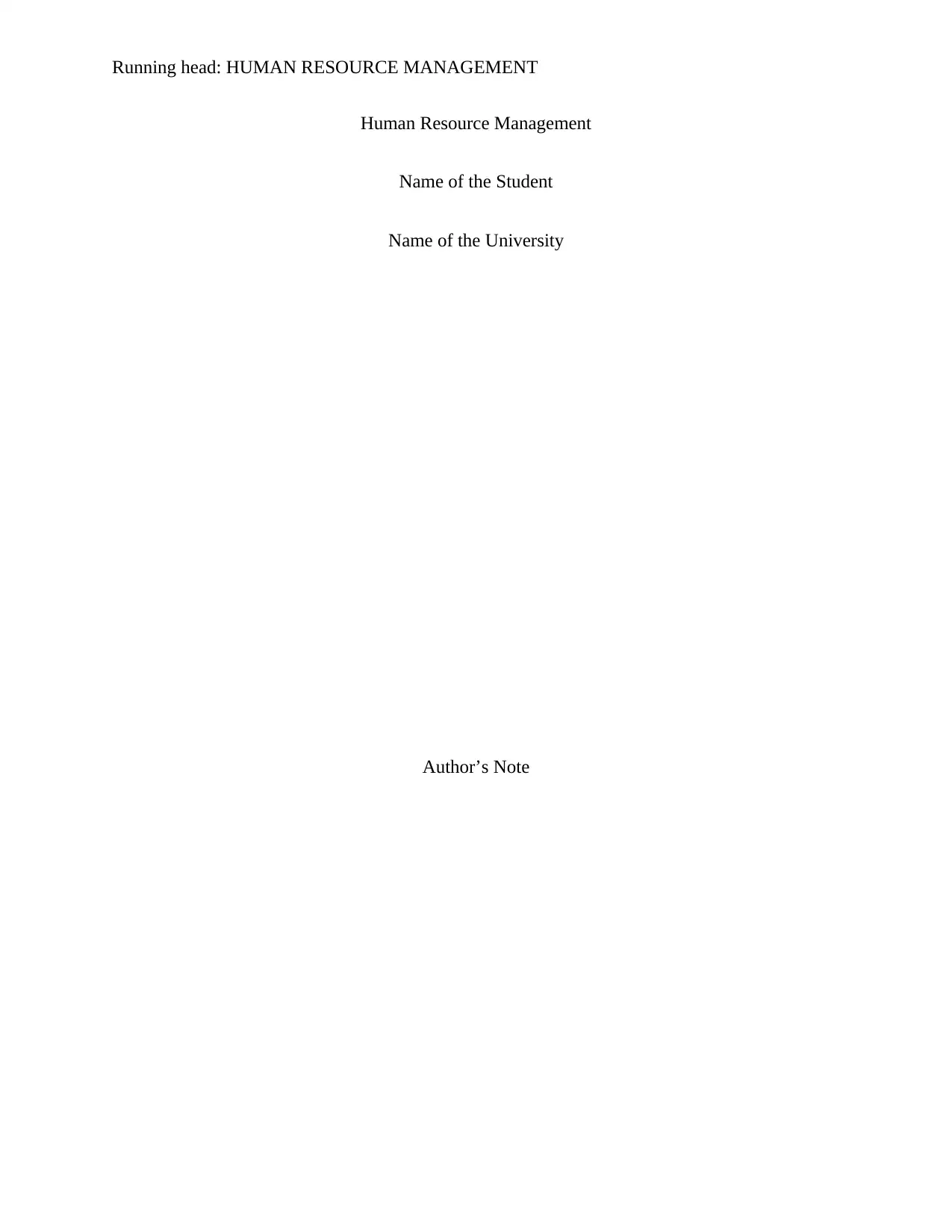
Running head: HUMAN RESOURCE MANAGEMENT
Human Resource Management
Name of the Student
Name of the University
Author’s Note
Human Resource Management
Name of the Student
Name of the University
Author’s Note
Paraphrase This Document
Need a fresh take? Get an instant paraphrase of this document with our AI Paraphraser
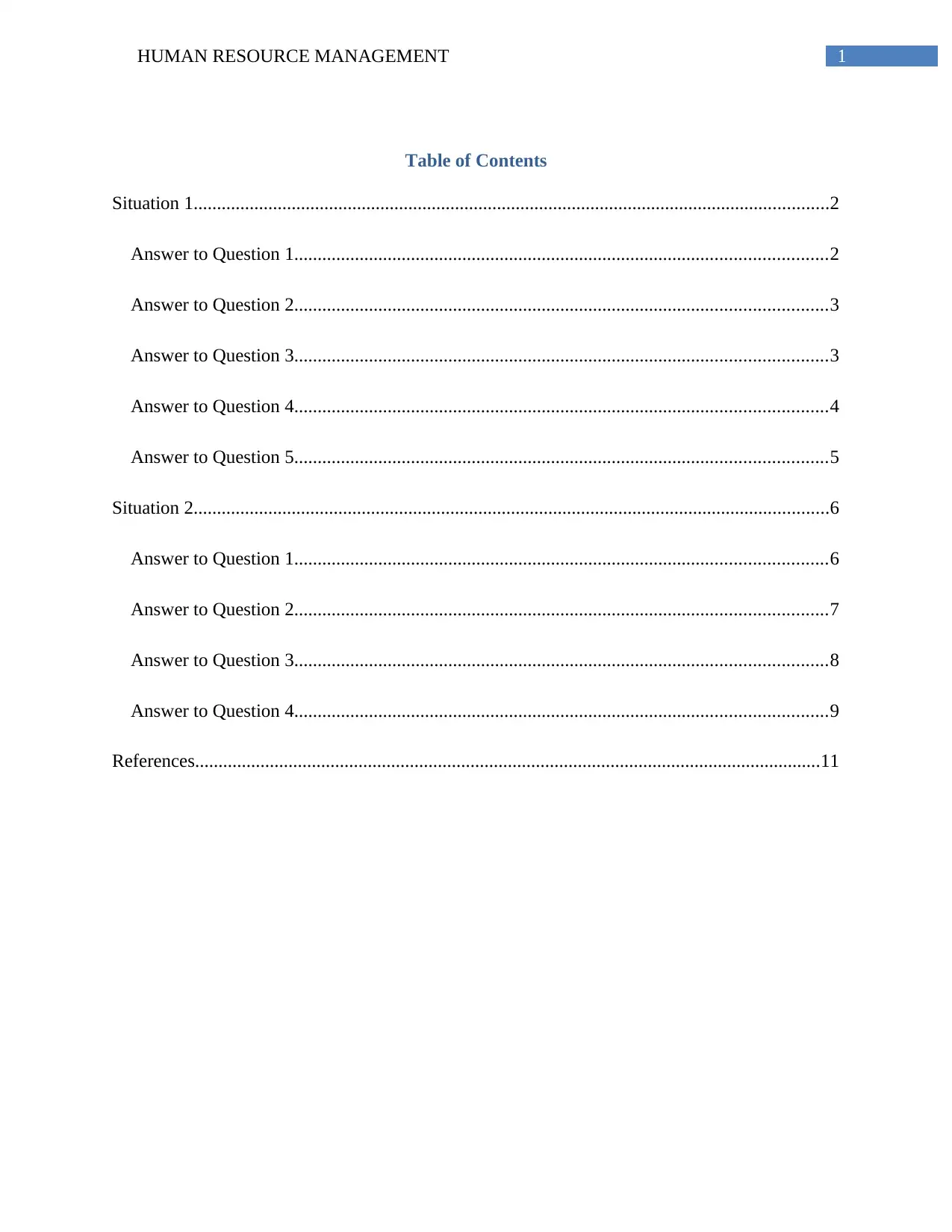
1HUMAN RESOURCE MANAGEMENT
Table of Contents
Situation 1........................................................................................................................................2
Answer to Question 1..................................................................................................................2
Answer to Question 2..................................................................................................................3
Answer to Question 3..................................................................................................................3
Answer to Question 4..................................................................................................................4
Answer to Question 5..................................................................................................................5
Situation 2........................................................................................................................................6
Answer to Question 1..................................................................................................................6
Answer to Question 2..................................................................................................................7
Answer to Question 3..................................................................................................................8
Answer to Question 4..................................................................................................................9
References......................................................................................................................................11
Table of Contents
Situation 1........................................................................................................................................2
Answer to Question 1..................................................................................................................2
Answer to Question 2..................................................................................................................3
Answer to Question 3..................................................................................................................3
Answer to Question 4..................................................................................................................4
Answer to Question 5..................................................................................................................5
Situation 2........................................................................................................................................6
Answer to Question 1..................................................................................................................6
Answer to Question 2..................................................................................................................7
Answer to Question 3..................................................................................................................8
Answer to Question 4..................................................................................................................9
References......................................................................................................................................11
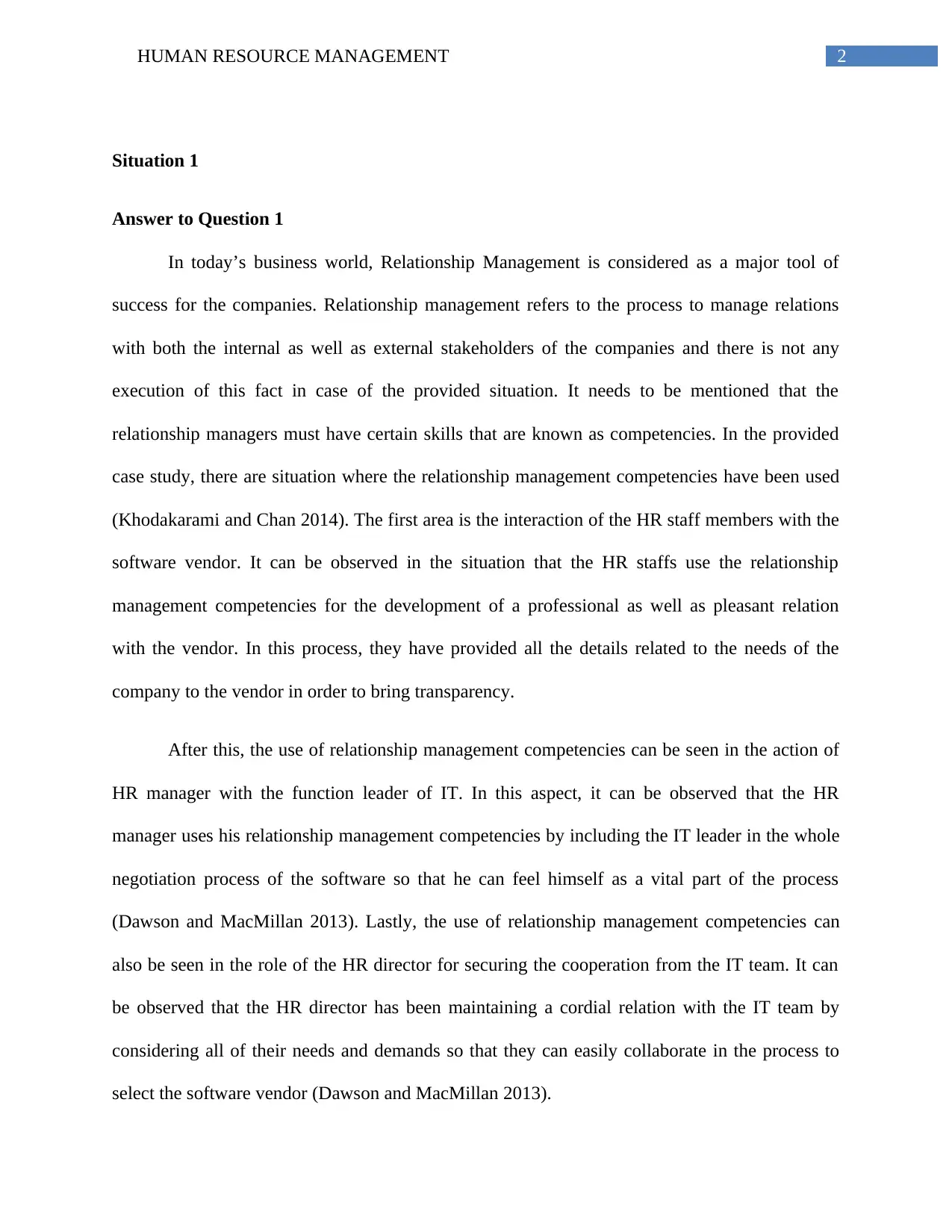
2HUMAN RESOURCE MANAGEMENT
Situation 1
Answer to Question 1
In today’s business world, Relationship Management is considered as a major tool of
success for the companies. Relationship management refers to the process to manage relations
with both the internal as well as external stakeholders of the companies and there is not any
execution of this fact in case of the provided situation. It needs to be mentioned that the
relationship managers must have certain skills that are known as competencies. In the provided
case study, there are situation where the relationship management competencies have been used
(Khodakarami and Chan 2014). The first area is the interaction of the HR staff members with the
software vendor. It can be observed in the situation that the HR staffs use the relationship
management competencies for the development of a professional as well as pleasant relation
with the vendor. In this process, they have provided all the details related to the needs of the
company to the vendor in order to bring transparency.
After this, the use of relationship management competencies can be seen in the action of
HR manager with the function leader of IT. In this aspect, it can be observed that the HR
manager uses his relationship management competencies by including the IT leader in the whole
negotiation process of the software so that he can feel himself as a vital part of the process
(Dawson and MacMillan 2013). Lastly, the use of relationship management competencies can
also be seen in the role of the HR director for securing the cooperation from the IT team. It can
be observed that the HR director has been maintaining a cordial relation with the IT team by
considering all of their needs and demands so that they can easily collaborate in the process to
select the software vendor (Dawson and MacMillan 2013).
Situation 1
Answer to Question 1
In today’s business world, Relationship Management is considered as a major tool of
success for the companies. Relationship management refers to the process to manage relations
with both the internal as well as external stakeholders of the companies and there is not any
execution of this fact in case of the provided situation. It needs to be mentioned that the
relationship managers must have certain skills that are known as competencies. In the provided
case study, there are situation where the relationship management competencies have been used
(Khodakarami and Chan 2014). The first area is the interaction of the HR staff members with the
software vendor. It can be observed in the situation that the HR staffs use the relationship
management competencies for the development of a professional as well as pleasant relation
with the vendor. In this process, they have provided all the details related to the needs of the
company to the vendor in order to bring transparency.
After this, the use of relationship management competencies can be seen in the action of
HR manager with the function leader of IT. In this aspect, it can be observed that the HR
manager uses his relationship management competencies by including the IT leader in the whole
negotiation process of the software so that he can feel himself as a vital part of the process
(Dawson and MacMillan 2013). Lastly, the use of relationship management competencies can
also be seen in the role of the HR director for securing the cooperation from the IT team. It can
be observed that the HR director has been maintaining a cordial relation with the IT team by
considering all of their needs and demands so that they can easily collaborate in the process to
select the software vendor (Dawson and MacMillan 2013).
⊘ This is a preview!⊘
Do you want full access?
Subscribe today to unlock all pages.

Trusted by 1+ million students worldwide
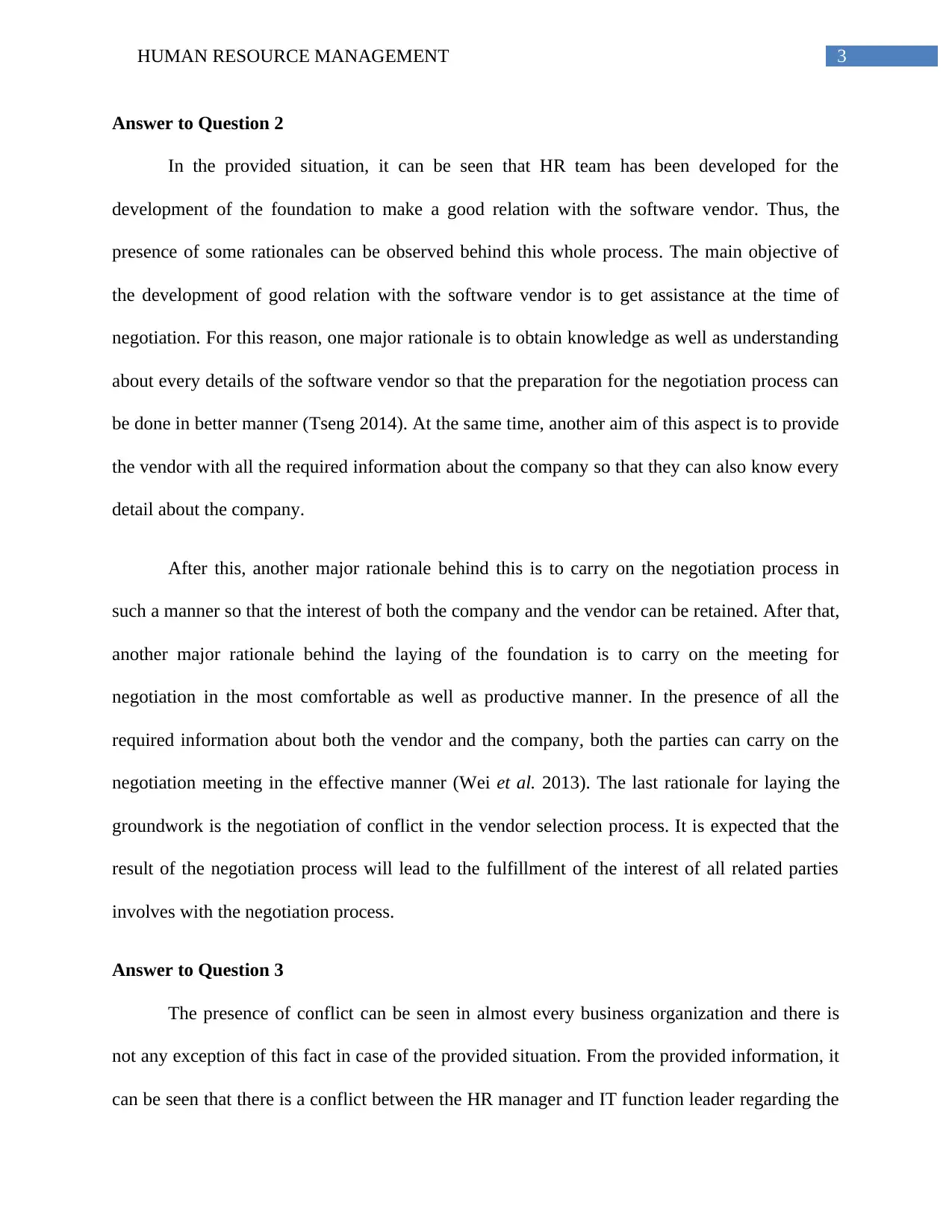
3HUMAN RESOURCE MANAGEMENT
Answer to Question 2
In the provided situation, it can be seen that HR team has been developed for the
development of the foundation to make a good relation with the software vendor. Thus, the
presence of some rationales can be observed behind this whole process. The main objective of
the development of good relation with the software vendor is to get assistance at the time of
negotiation. For this reason, one major rationale is to obtain knowledge as well as understanding
about every details of the software vendor so that the preparation for the negotiation process can
be done in better manner (Tseng 2014). At the same time, another aim of this aspect is to provide
the vendor with all the required information about the company so that they can also know every
detail about the company.
After this, another major rationale behind this is to carry on the negotiation process in
such a manner so that the interest of both the company and the vendor can be retained. After that,
another major rationale behind the laying of the foundation is to carry on the meeting for
negotiation in the most comfortable as well as productive manner. In the presence of all the
required information about both the vendor and the company, both the parties can carry on the
negotiation meeting in the effective manner (Wei et al. 2013). The last rationale for laying the
groundwork is the negotiation of conflict in the vendor selection process. It is expected that the
result of the negotiation process will lead to the fulfillment of the interest of all related parties
involves with the negotiation process.
Answer to Question 3
The presence of conflict can be seen in almost every business organization and there is
not any exception of this fact in case of the provided situation. From the provided information, it
can be seen that there is a conflict between the HR manager and IT function leader regarding the
Answer to Question 2
In the provided situation, it can be seen that HR team has been developed for the
development of the foundation to make a good relation with the software vendor. Thus, the
presence of some rationales can be observed behind this whole process. The main objective of
the development of good relation with the software vendor is to get assistance at the time of
negotiation. For this reason, one major rationale is to obtain knowledge as well as understanding
about every details of the software vendor so that the preparation for the negotiation process can
be done in better manner (Tseng 2014). At the same time, another aim of this aspect is to provide
the vendor with all the required information about the company so that they can also know every
detail about the company.
After this, another major rationale behind this is to carry on the negotiation process in
such a manner so that the interest of both the company and the vendor can be retained. After that,
another major rationale behind the laying of the foundation is to carry on the meeting for
negotiation in the most comfortable as well as productive manner. In the presence of all the
required information about both the vendor and the company, both the parties can carry on the
negotiation meeting in the effective manner (Wei et al. 2013). The last rationale for laying the
groundwork is the negotiation of conflict in the vendor selection process. It is expected that the
result of the negotiation process will lead to the fulfillment of the interest of all related parties
involves with the negotiation process.
Answer to Question 3
The presence of conflict can be seen in almost every business organization and there is
not any exception of this fact in case of the provided situation. From the provided information, it
can be seen that there is a conflict between the HR manager and IT function leader regarding the
Paraphrase This Document
Need a fresh take? Get an instant paraphrase of this document with our AI Paraphraser
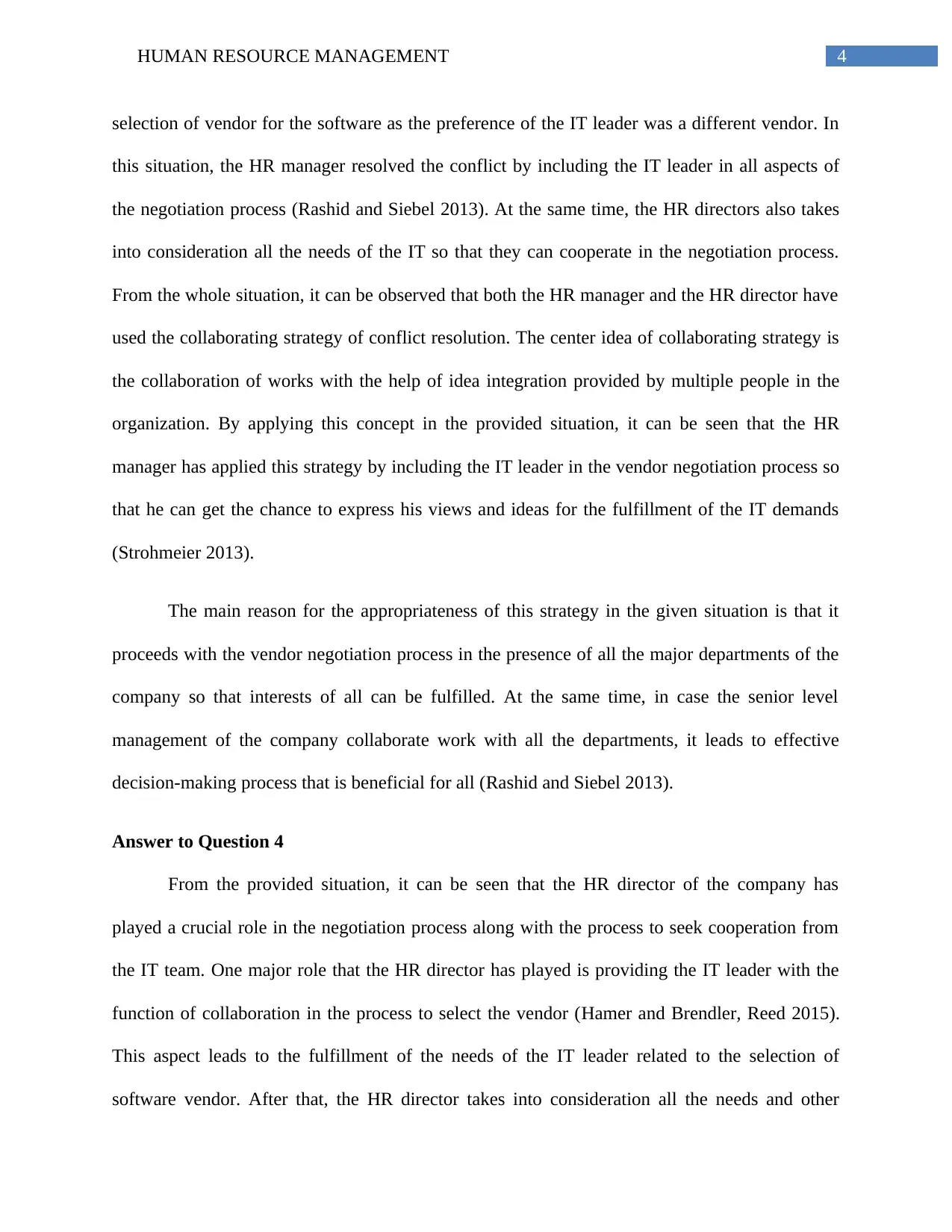
4HUMAN RESOURCE MANAGEMENT
selection of vendor for the software as the preference of the IT leader was a different vendor. In
this situation, the HR manager resolved the conflict by including the IT leader in all aspects of
the negotiation process (Rashid and Siebel 2013). At the same time, the HR directors also takes
into consideration all the needs of the IT so that they can cooperate in the negotiation process.
From the whole situation, it can be observed that both the HR manager and the HR director have
used the collaborating strategy of conflict resolution. The center idea of collaborating strategy is
the collaboration of works with the help of idea integration provided by multiple people in the
organization. By applying this concept in the provided situation, it can be seen that the HR
manager has applied this strategy by including the IT leader in the vendor negotiation process so
that he can get the chance to express his views and ideas for the fulfillment of the IT demands
(Strohmeier 2013).
The main reason for the appropriateness of this strategy in the given situation is that it
proceeds with the vendor negotiation process in the presence of all the major departments of the
company so that interests of all can be fulfilled. At the same time, in case the senior level
management of the company collaborate work with all the departments, it leads to effective
decision-making process that is beneficial for all (Rashid and Siebel 2013).
Answer to Question 4
From the provided situation, it can be seen that the HR director of the company has
played a crucial role in the negotiation process along with the process to seek cooperation from
the IT team. One major role that the HR director has played is providing the IT leader with the
function of collaboration in the process to select the vendor (Hamer and Brendler, Reed 2015).
This aspect leads to the fulfillment of the needs of the IT leader related to the selection of
software vendor. After that, the HR director takes into consideration all the needs and other
selection of vendor for the software as the preference of the IT leader was a different vendor. In
this situation, the HR manager resolved the conflict by including the IT leader in all aspects of
the negotiation process (Rashid and Siebel 2013). At the same time, the HR directors also takes
into consideration all the needs of the IT so that they can cooperate in the negotiation process.
From the whole situation, it can be observed that both the HR manager and the HR director have
used the collaborating strategy of conflict resolution. The center idea of collaborating strategy is
the collaboration of works with the help of idea integration provided by multiple people in the
organization. By applying this concept in the provided situation, it can be seen that the HR
manager has applied this strategy by including the IT leader in the vendor negotiation process so
that he can get the chance to express his views and ideas for the fulfillment of the IT demands
(Strohmeier 2013).
The main reason for the appropriateness of this strategy in the given situation is that it
proceeds with the vendor negotiation process in the presence of all the major departments of the
company so that interests of all can be fulfilled. At the same time, in case the senior level
management of the company collaborate work with all the departments, it leads to effective
decision-making process that is beneficial for all (Rashid and Siebel 2013).
Answer to Question 4
From the provided situation, it can be seen that the HR director of the company has
played a crucial role in the negotiation process along with the process to seek cooperation from
the IT team. One major role that the HR director has played is providing the IT leader with the
function of collaboration in the process to select the vendor (Hamer and Brendler, Reed 2015).
This aspect leads to the fulfillment of the needs of the IT leader related to the selection of
software vendor. After that, the HR director takes into consideration all the needs and other
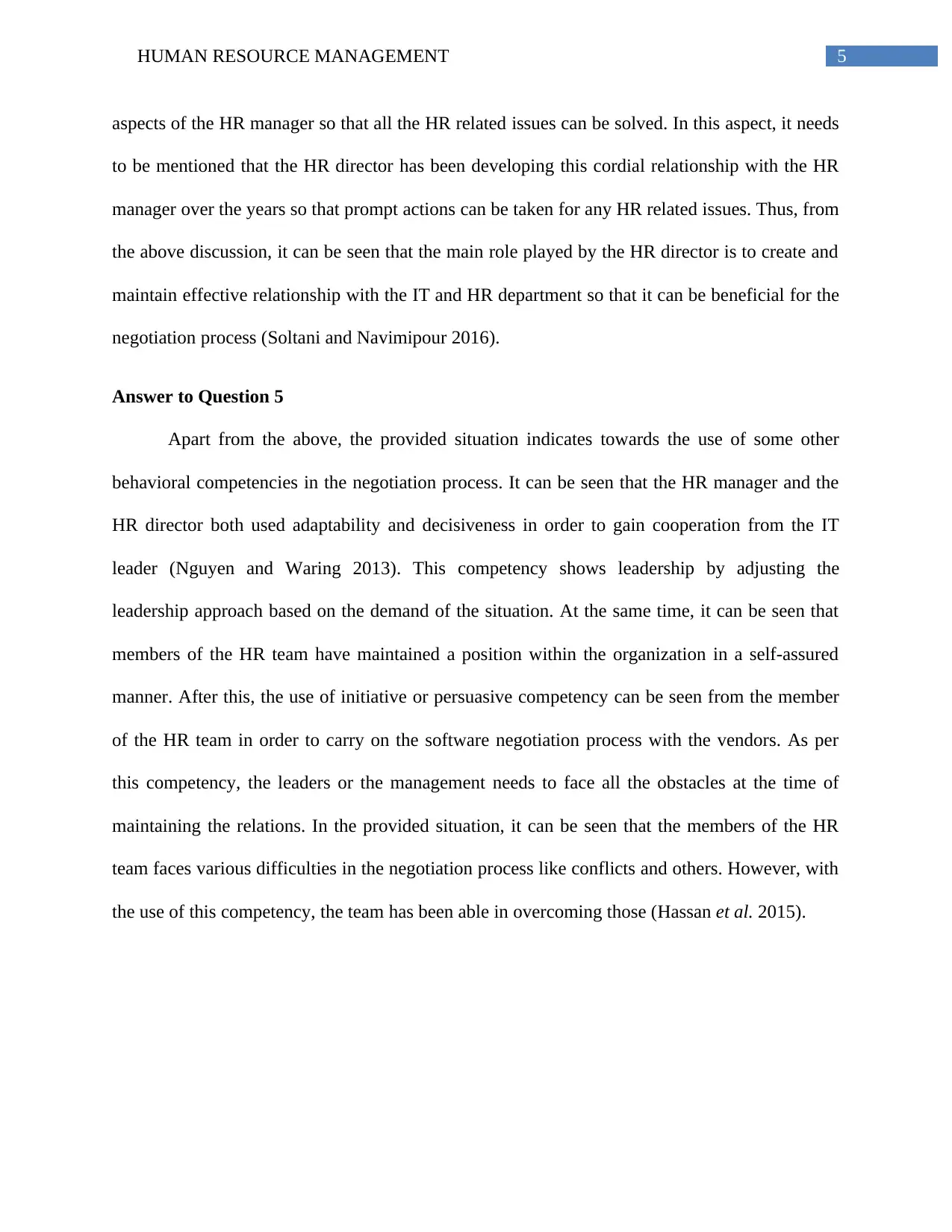
5HUMAN RESOURCE MANAGEMENT
aspects of the HR manager so that all the HR related issues can be solved. In this aspect, it needs
to be mentioned that the HR director has been developing this cordial relationship with the HR
manager over the years so that prompt actions can be taken for any HR related issues. Thus, from
the above discussion, it can be seen that the main role played by the HR director is to create and
maintain effective relationship with the IT and HR department so that it can be beneficial for the
negotiation process (Soltani and Navimipour 2016).
Answer to Question 5
Apart from the above, the provided situation indicates towards the use of some other
behavioral competencies in the negotiation process. It can be seen that the HR manager and the
HR director both used adaptability and decisiveness in order to gain cooperation from the IT
leader (Nguyen and Waring 2013). This competency shows leadership by adjusting the
leadership approach based on the demand of the situation. At the same time, it can be seen that
members of the HR team have maintained a position within the organization in a self-assured
manner. After this, the use of initiative or persuasive competency can be seen from the member
of the HR team in order to carry on the software negotiation process with the vendors. As per
this competency, the leaders or the management needs to face all the obstacles at the time of
maintaining the relations. In the provided situation, it can be seen that the members of the HR
team faces various difficulties in the negotiation process like conflicts and others. However, with
the use of this competency, the team has been able in overcoming those (Hassan et al. 2015).
aspects of the HR manager so that all the HR related issues can be solved. In this aspect, it needs
to be mentioned that the HR director has been developing this cordial relationship with the HR
manager over the years so that prompt actions can be taken for any HR related issues. Thus, from
the above discussion, it can be seen that the main role played by the HR director is to create and
maintain effective relationship with the IT and HR department so that it can be beneficial for the
negotiation process (Soltani and Navimipour 2016).
Answer to Question 5
Apart from the above, the provided situation indicates towards the use of some other
behavioral competencies in the negotiation process. It can be seen that the HR manager and the
HR director both used adaptability and decisiveness in order to gain cooperation from the IT
leader (Nguyen and Waring 2013). This competency shows leadership by adjusting the
leadership approach based on the demand of the situation. At the same time, it can be seen that
members of the HR team have maintained a position within the organization in a self-assured
manner. After this, the use of initiative or persuasive competency can be seen from the member
of the HR team in order to carry on the software negotiation process with the vendors. As per
this competency, the leaders or the management needs to face all the obstacles at the time of
maintaining the relations. In the provided situation, it can be seen that the members of the HR
team faces various difficulties in the negotiation process like conflicts and others. However, with
the use of this competency, the team has been able in overcoming those (Hassan et al. 2015).
⊘ This is a preview!⊘
Do you want full access?
Subscribe today to unlock all pages.

Trusted by 1+ million students worldwide
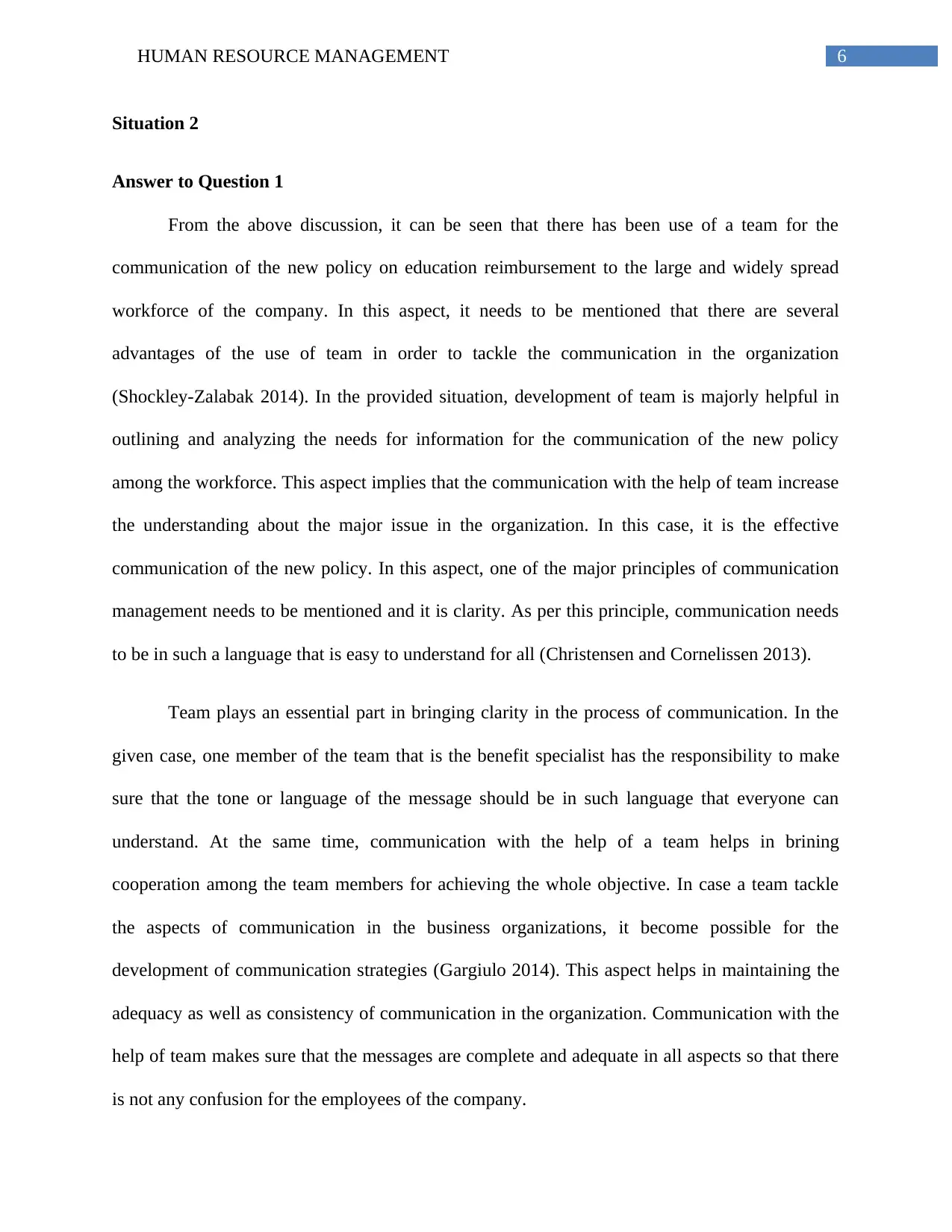
6HUMAN RESOURCE MANAGEMENT
Situation 2
Answer to Question 1
From the above discussion, it can be seen that there has been use of a team for the
communication of the new policy on education reimbursement to the large and widely spread
workforce of the company. In this aspect, it needs to be mentioned that there are several
advantages of the use of team in order to tackle the communication in the organization
(Shockley-Zalabak 2014). In the provided situation, development of team is majorly helpful in
outlining and analyzing the needs for information for the communication of the new policy
among the workforce. This aspect implies that the communication with the help of team increase
the understanding about the major issue in the organization. In this case, it is the effective
communication of the new policy. In this aspect, one of the major principles of communication
management needs to be mentioned and it is clarity. As per this principle, communication needs
to be in such a language that is easy to understand for all (Christensen and Cornelissen 2013).
Team plays an essential part in bringing clarity in the process of communication. In the
given case, one member of the team that is the benefit specialist has the responsibility to make
sure that the tone or language of the message should be in such language that everyone can
understand. At the same time, communication with the help of a team helps in brining
cooperation among the team members for achieving the whole objective. In case a team tackle
the aspects of communication in the business organizations, it become possible for the
development of communication strategies (Gargiulo 2014). This aspect helps in maintaining the
adequacy as well as consistency of communication in the organization. Communication with the
help of team makes sure that the messages are complete and adequate in all aspects so that there
is not any confusion for the employees of the company.
Situation 2
Answer to Question 1
From the above discussion, it can be seen that there has been use of a team for the
communication of the new policy on education reimbursement to the large and widely spread
workforce of the company. In this aspect, it needs to be mentioned that there are several
advantages of the use of team in order to tackle the communication in the organization
(Shockley-Zalabak 2014). In the provided situation, development of team is majorly helpful in
outlining and analyzing the needs for information for the communication of the new policy
among the workforce. This aspect implies that the communication with the help of team increase
the understanding about the major issue in the organization. In this case, it is the effective
communication of the new policy. In this aspect, one of the major principles of communication
management needs to be mentioned and it is clarity. As per this principle, communication needs
to be in such a language that is easy to understand for all (Christensen and Cornelissen 2013).
Team plays an essential part in bringing clarity in the process of communication. In the
given case, one member of the team that is the benefit specialist has the responsibility to make
sure that the tone or language of the message should be in such language that everyone can
understand. At the same time, communication with the help of a team helps in brining
cooperation among the team members for achieving the whole objective. In case a team tackle
the aspects of communication in the business organizations, it become possible for the
development of communication strategies (Gargiulo 2014). This aspect helps in maintaining the
adequacy as well as consistency of communication in the organization. Communication with the
help of team makes sure that the messages are complete and adequate in all aspects so that there
is not any confusion for the employees of the company.
Paraphrase This Document
Need a fresh take? Get an instant paraphrase of this document with our AI Paraphraser

7HUMAN RESOURCE MANAGEMENT
Answer to Question 2
From the provided information about the given case study, it can be seen that the team
responsible for the effective communication of the new policy related to educational
reimbursement has taken the strategy of breaking the whole communication process in some
specific segment (Falkheimer 2014). In this context, it needs to be mentioned that this adopted
strategy of the communication team has certain advantages in the organizations for the process of
communicating this news to the respected audiences. The provided information indicates that the
policy has been properly communicated at the end. It implies that the segmentation process of
communicating the policy is successful. The main advantage of the segmentation of
communication is the effective flow of information to the employees without losing any
information. There are many instances where lost of information can be seen due to the lack of
effective communication medium (Sotirin 2014).
In the provided scenario, the segmentation of the communication has been done by
including the managers in the communication process with the help of video conference. This
process allows the managers of the company to clear all their confusions as well as queries
regarding related to the introduction of policy (Jiang and Men 2017). In this process, the
managers of the organization will be able in communicating the content of the policy among the
large employees in effective manner. At the same time, the managers will be able in answering
all the questions of the employees related to the policy in detailed manner. Thus, it can be
observed that the segmentation of the communication process results in clear communication
among the audiences without losing any major part of the information and the provided case
study can be provided as a major example for the advantage of segmentation of communication
(Sotirin 2014).
Answer to Question 2
From the provided information about the given case study, it can be seen that the team
responsible for the effective communication of the new policy related to educational
reimbursement has taken the strategy of breaking the whole communication process in some
specific segment (Falkheimer 2014). In this context, it needs to be mentioned that this adopted
strategy of the communication team has certain advantages in the organizations for the process of
communicating this news to the respected audiences. The provided information indicates that the
policy has been properly communicated at the end. It implies that the segmentation process of
communicating the policy is successful. The main advantage of the segmentation of
communication is the effective flow of information to the employees without losing any
information. There are many instances where lost of information can be seen due to the lack of
effective communication medium (Sotirin 2014).
In the provided scenario, the segmentation of the communication has been done by
including the managers in the communication process with the help of video conference. This
process allows the managers of the company to clear all their confusions as well as queries
regarding related to the introduction of policy (Jiang and Men 2017). In this process, the
managers of the organization will be able in communicating the content of the policy among the
large employees in effective manner. At the same time, the managers will be able in answering
all the questions of the employees related to the policy in detailed manner. Thus, it can be
observed that the segmentation of the communication process results in clear communication
among the audiences without losing any major part of the information and the provided case
study can be provided as a major example for the advantage of segmentation of communication
(Sotirin 2014).
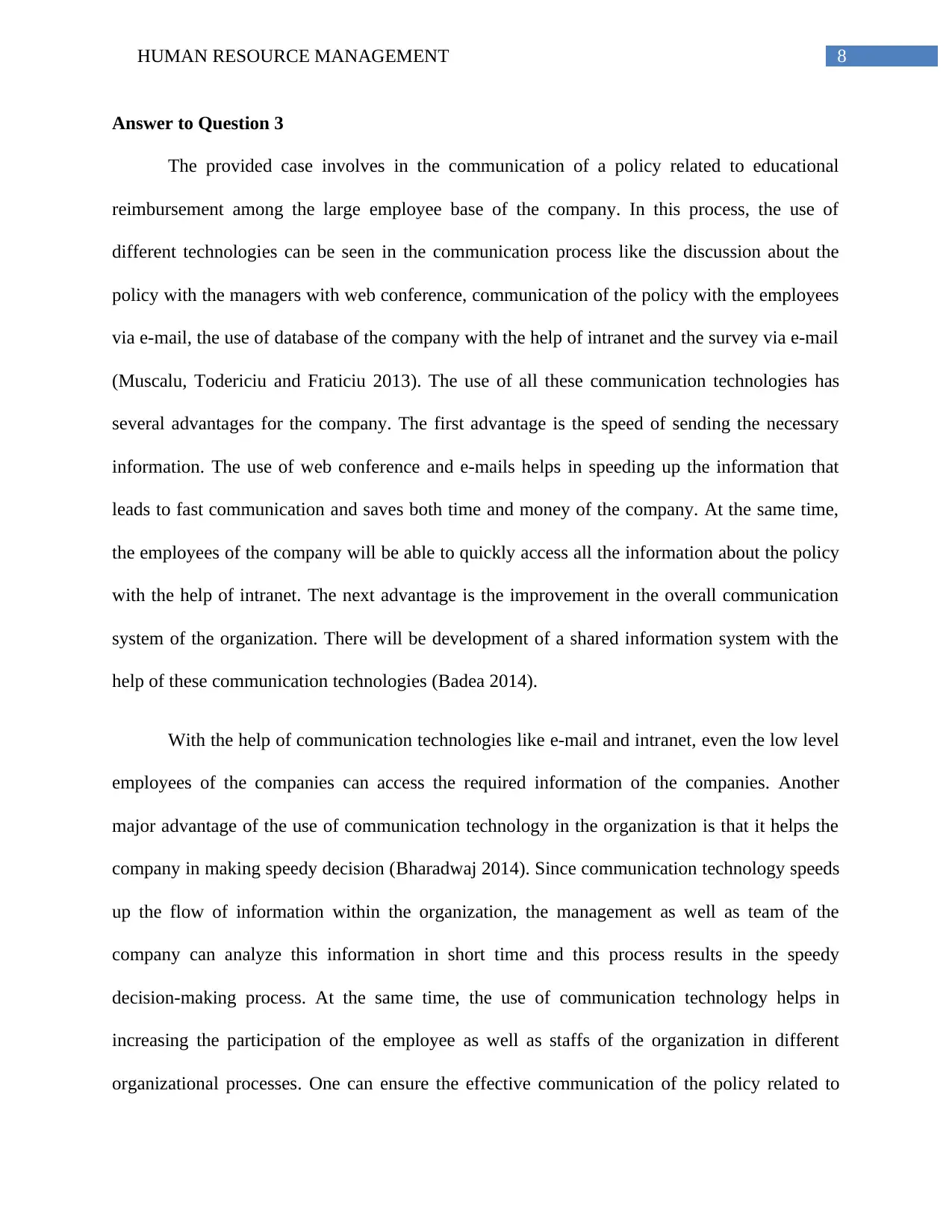
8HUMAN RESOURCE MANAGEMENT
Answer to Question 3
The provided case involves in the communication of a policy related to educational
reimbursement among the large employee base of the company. In this process, the use of
different technologies can be seen in the communication process like the discussion about the
policy with the managers with web conference, communication of the policy with the employees
via e-mail, the use of database of the company with the help of intranet and the survey via e-mail
(Muscalu, Todericiu and Fraticiu 2013). The use of all these communication technologies has
several advantages for the company. The first advantage is the speed of sending the necessary
information. The use of web conference and e-mails helps in speeding up the information that
leads to fast communication and saves both time and money of the company. At the same time,
the employees of the company will be able to quickly access all the information about the policy
with the help of intranet. The next advantage is the improvement in the overall communication
system of the organization. There will be development of a shared information system with the
help of these communication technologies (Badea 2014).
With the help of communication technologies like e-mail and intranet, even the low level
employees of the companies can access the required information of the companies. Another
major advantage of the use of communication technology in the organization is that it helps the
company in making speedy decision (Bharadwaj 2014). Since communication technology speeds
up the flow of information within the organization, the management as well as team of the
company can analyze this information in short time and this process results in the speedy
decision-making process. At the same time, the use of communication technology helps in
increasing the participation of the employee as well as staffs of the organization in different
organizational processes. One can ensure the effective communication of the policy related to
Answer to Question 3
The provided case involves in the communication of a policy related to educational
reimbursement among the large employee base of the company. In this process, the use of
different technologies can be seen in the communication process like the discussion about the
policy with the managers with web conference, communication of the policy with the employees
via e-mail, the use of database of the company with the help of intranet and the survey via e-mail
(Muscalu, Todericiu and Fraticiu 2013). The use of all these communication technologies has
several advantages for the company. The first advantage is the speed of sending the necessary
information. The use of web conference and e-mails helps in speeding up the information that
leads to fast communication and saves both time and money of the company. At the same time,
the employees of the company will be able to quickly access all the information about the policy
with the help of intranet. The next advantage is the improvement in the overall communication
system of the organization. There will be development of a shared information system with the
help of these communication technologies (Badea 2014).
With the help of communication technologies like e-mail and intranet, even the low level
employees of the companies can access the required information of the companies. Another
major advantage of the use of communication technology in the organization is that it helps the
company in making speedy decision (Bharadwaj 2014). Since communication technology speeds
up the flow of information within the organization, the management as well as team of the
company can analyze this information in short time and this process results in the speedy
decision-making process. At the same time, the use of communication technology helps in
increasing the participation of the employee as well as staffs of the organization in different
organizational processes. One can ensure the effective communication of the policy related to
⊘ This is a preview!⊘
Do you want full access?
Subscribe today to unlock all pages.

Trusted by 1+ million students worldwide
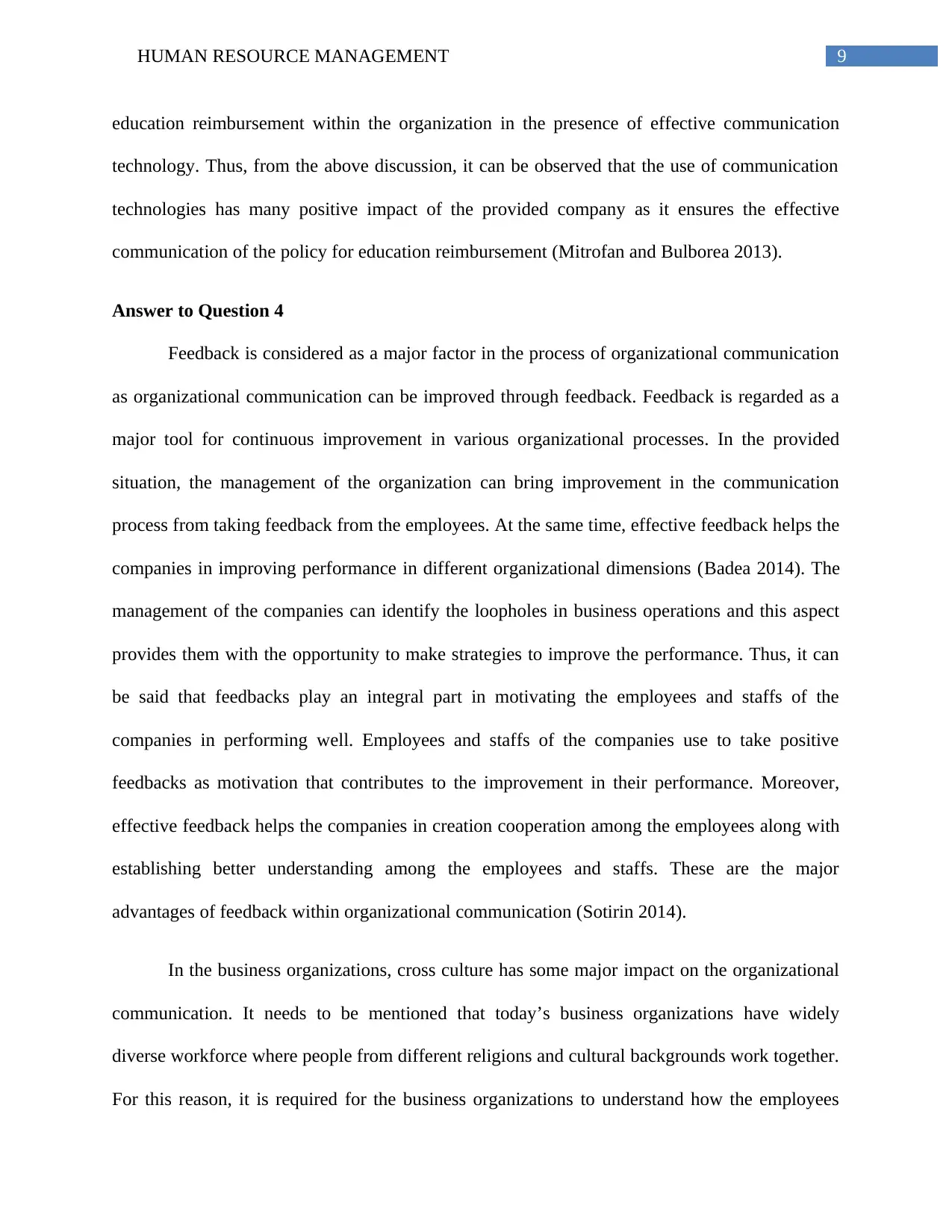
9HUMAN RESOURCE MANAGEMENT
education reimbursement within the organization in the presence of effective communication
technology. Thus, from the above discussion, it can be observed that the use of communication
technologies has many positive impact of the provided company as it ensures the effective
communication of the policy for education reimbursement (Mitrofan and Bulborea 2013).
Answer to Question 4
Feedback is considered as a major factor in the process of organizational communication
as organizational communication can be improved through feedback. Feedback is regarded as a
major tool for continuous improvement in various organizational processes. In the provided
situation, the management of the organization can bring improvement in the communication
process from taking feedback from the employees. At the same time, effective feedback helps the
companies in improving performance in different organizational dimensions (Badea 2014). The
management of the companies can identify the loopholes in business operations and this aspect
provides them with the opportunity to make strategies to improve the performance. Thus, it can
be said that feedbacks play an integral part in motivating the employees and staffs of the
companies in performing well. Employees and staffs of the companies use to take positive
feedbacks as motivation that contributes to the improvement in their performance. Moreover,
effective feedback helps the companies in creation cooperation among the employees along with
establishing better understanding among the employees and staffs. These are the major
advantages of feedback within organizational communication (Sotirin 2014).
In the business organizations, cross culture has some major impact on the organizational
communication. It needs to be mentioned that today’s business organizations have widely
diverse workforce where people from different religions and cultural backgrounds work together.
For this reason, it is required for the business organizations to understand how the employees
education reimbursement within the organization in the presence of effective communication
technology. Thus, from the above discussion, it can be observed that the use of communication
technologies has many positive impact of the provided company as it ensures the effective
communication of the policy for education reimbursement (Mitrofan and Bulborea 2013).
Answer to Question 4
Feedback is considered as a major factor in the process of organizational communication
as organizational communication can be improved through feedback. Feedback is regarded as a
major tool for continuous improvement in various organizational processes. In the provided
situation, the management of the organization can bring improvement in the communication
process from taking feedback from the employees. At the same time, effective feedback helps the
companies in improving performance in different organizational dimensions (Badea 2014). The
management of the companies can identify the loopholes in business operations and this aspect
provides them with the opportunity to make strategies to improve the performance. Thus, it can
be said that feedbacks play an integral part in motivating the employees and staffs of the
companies in performing well. Employees and staffs of the companies use to take positive
feedbacks as motivation that contributes to the improvement in their performance. Moreover,
effective feedback helps the companies in creation cooperation among the employees along with
establishing better understanding among the employees and staffs. These are the major
advantages of feedback within organizational communication (Sotirin 2014).
In the business organizations, cross culture has some major impact on the organizational
communication. It needs to be mentioned that today’s business organizations have widely
diverse workforce where people from different religions and cultural backgrounds work together.
For this reason, it is required for the business organizations to understand how the employees
Paraphrase This Document
Need a fresh take? Get an instant paraphrase of this document with our AI Paraphraser
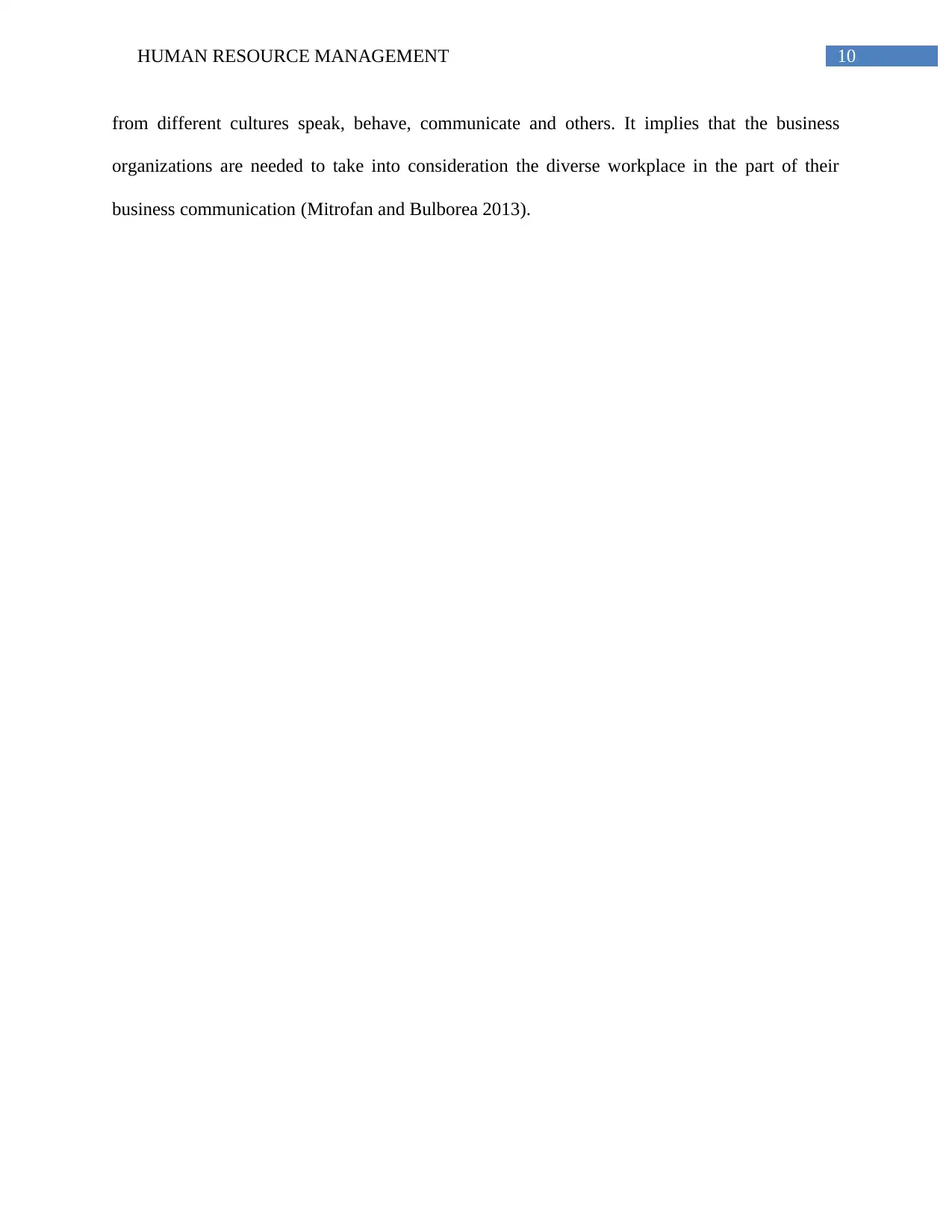
10HUMAN RESOURCE MANAGEMENT
from different cultures speak, behave, communicate and others. It implies that the business
organizations are needed to take into consideration the diverse workplace in the part of their
business communication (Mitrofan and Bulborea 2013).
from different cultures speak, behave, communicate and others. It implies that the business
organizations are needed to take into consideration the diverse workplace in the part of their
business communication (Mitrofan and Bulborea 2013).
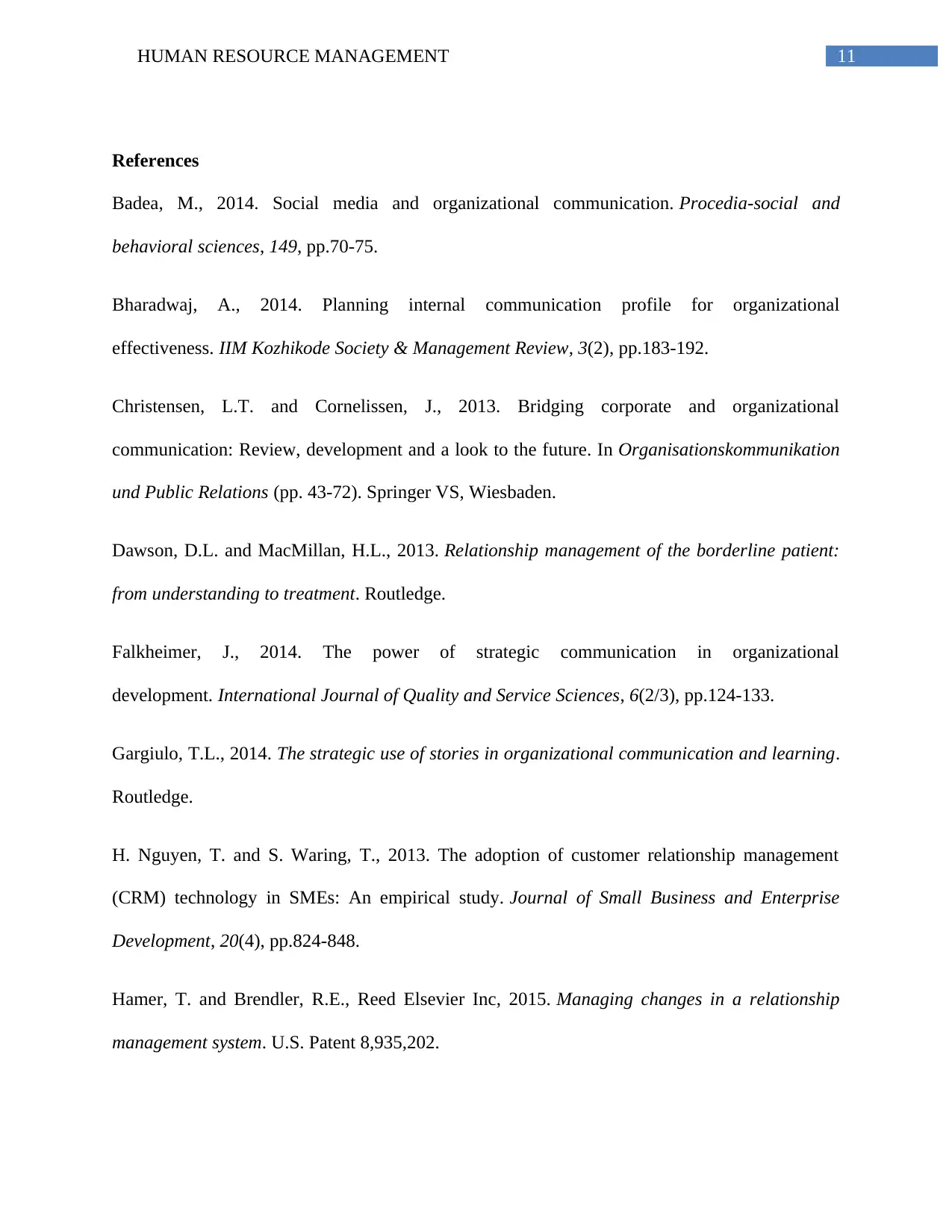
11HUMAN RESOURCE MANAGEMENT
References
Badea, M., 2014. Social media and organizational communication. Procedia-social and
behavioral sciences, 149, pp.70-75.
Bharadwaj, A., 2014. Planning internal communication profile for organizational
effectiveness. IIM Kozhikode Society & Management Review, 3(2), pp.183-192.
Christensen, L.T. and Cornelissen, J., 2013. Bridging corporate and organizational
communication: Review, development and a look to the future. In Organisationskommunikation
und Public Relations (pp. 43-72). Springer VS, Wiesbaden.
Dawson, D.L. and MacMillan, H.L., 2013. Relationship management of the borderline patient:
from understanding to treatment. Routledge.
Falkheimer, J., 2014. The power of strategic communication in organizational
development. International Journal of Quality and Service Sciences, 6(2/3), pp.124-133.
Gargiulo, T.L., 2014. The strategic use of stories in organizational communication and learning.
Routledge.
H. Nguyen, T. and S. Waring, T., 2013. The adoption of customer relationship management
(CRM) technology in SMEs: An empirical study. Journal of Small Business and Enterprise
Development, 20(4), pp.824-848.
Hamer, T. and Brendler, R.E., Reed Elsevier Inc, 2015. Managing changes in a relationship
management system. U.S. Patent 8,935,202.
References
Badea, M., 2014. Social media and organizational communication. Procedia-social and
behavioral sciences, 149, pp.70-75.
Bharadwaj, A., 2014. Planning internal communication profile for organizational
effectiveness. IIM Kozhikode Society & Management Review, 3(2), pp.183-192.
Christensen, L.T. and Cornelissen, J., 2013. Bridging corporate and organizational
communication: Review, development and a look to the future. In Organisationskommunikation
und Public Relations (pp. 43-72). Springer VS, Wiesbaden.
Dawson, D.L. and MacMillan, H.L., 2013. Relationship management of the borderline patient:
from understanding to treatment. Routledge.
Falkheimer, J., 2014. The power of strategic communication in organizational
development. International Journal of Quality and Service Sciences, 6(2/3), pp.124-133.
Gargiulo, T.L., 2014. The strategic use of stories in organizational communication and learning.
Routledge.
H. Nguyen, T. and S. Waring, T., 2013. The adoption of customer relationship management
(CRM) technology in SMEs: An empirical study. Journal of Small Business and Enterprise
Development, 20(4), pp.824-848.
Hamer, T. and Brendler, R.E., Reed Elsevier Inc, 2015. Managing changes in a relationship
management system. U.S. Patent 8,935,202.
⊘ This is a preview!⊘
Do you want full access?
Subscribe today to unlock all pages.

Trusted by 1+ million students worldwide
1 out of 14
Related Documents
Your All-in-One AI-Powered Toolkit for Academic Success.
+13062052269
info@desklib.com
Available 24*7 on WhatsApp / Email
![[object Object]](/_next/static/media/star-bottom.7253800d.svg)
Unlock your academic potential
Copyright © 2020–2025 A2Z Services. All Rights Reserved. Developed and managed by ZUCOL.




